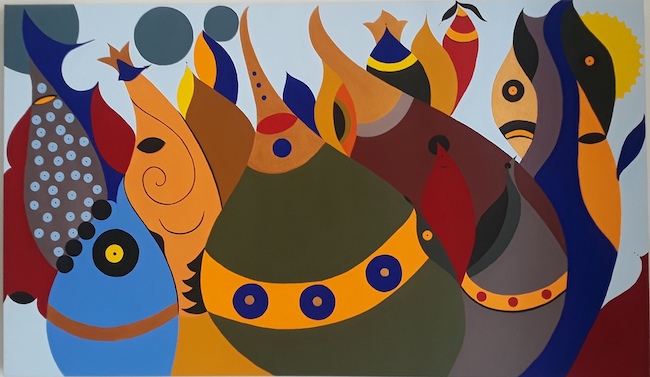L’arte contemporanea presenta spesso la singolare caratteristica di porsi come sintesi di diversi linguaggi pittorici precedenti i quali erano, nelle epoche in cui si sono sviluppati, rimasti nettamente distaccati e lontani sia dal punto di vista delle regole espressive sia da quello dell’intento creativo; gli artisti del Ventunesimo secolo tendono al contrario a sfumare i confini e fondere stili per dar vita a una propria e personale cifra espressiva. L’artista di cui vi racconterò oggi appartiene a quella categoria di creativi che necessitano generare qualcosa di nuovo, laddove prima non c’era.
I primi decenni del Novecento furono una fucina di innovazioni e di stravolgimenti dell’arte così come intesa fino al secolo precedente, nuovi pensieri che spesso tendevano a osteggiarsi l’un l’altro, mantenendo i saldi princìpi e le nette linee di demarcazione che ne formalizzavano l’identità così come teorizzate dai loro fondatori. Eppure furono proprio i geni da cui nacquero le maggiori correnti a dare un’impronta personale distintiva a un modo di fare e di intendere la pittura che sconvolse completamente le regole accademiche ed esecutive fino a poco prima adottate e considerate come le uniche possibili. In particolare vi furono alcuni movimenti pittorici che vollero distinguersi dagli altri più diffusi e popolari agli inizi del Ventesimo secolo, movimenti che apparvero comprimari o derivazioni degli altri ma che in realtà, sebbene più di nicchia, ebbero una rilevanza per ulteriori sviluppi e contaminazioni dell’arte che seguì a quegli inizi del secolo. Kazimir Malevich fu il fondatore del Suprematismo, che fece da base teorica anche dal De Stijl, ma giunse a quell’astrazione attraverso un percorso di semplificazione dell’immagine osservata, attraverso un’eliminazione della terza dimensione e del chiaroscuro dell’arte accademica, e una riduzione delle sfumature in favore del colore pieno, quasi con un approccio grafico che lentamente si andò snellendo fino a raggiungere l’astrazione verso le forme geometriche e l’esclusione delle tonalità cromatiche intermedie. Il Cubismo ebbe una sostanziale variazione quando Robert e Sonia Delauny ne vivacizzarono i colori e al tempo stesso si indirizzarono verso una forma espressiva più orientata all’Astrattismo che non alla figurazione, pur scomponendo e frammentando le linee, rette ma prevalentemente curve, che li indussero a tenersi legati al concetto base del movimento a cui aderirono e che modificarono in quello da loro fondato denominato Orfismo, o Cubismo Orfico. E infine Henri Matisse, nel suo periodo di transizione tra l’iniziale stile Fauve seguito dal periodo Naif prima ed espressionista poi, e quello in cui l’incursione verso l’astrattismo si faceva più impellente, ha a sua volta semplificato le forme fino a farle divenire comprimarie di un mondo in cui le sagome ondulate usate per descrivere la realtà erano più importanti del soggetto protagonista della tela, tanto quanto i colori piatti e intensi lo erano per narrare il suo mondo di eterno bambino. L’artista di origine russa ma residente a Venezia da diciotto anni Valentyna Ohurtsova, sembra porsi come sintesi, o per meglio dire congiunzione di questi tre particolari e unici stili che le sono necessari per osservare ed elaborare la realtà intorno a sé meditando sulle circostanze, sugli eventi, su tutto ciò che in qualche modo avvolge e coinvolge l’animo umano e il vivere contemporaneo.
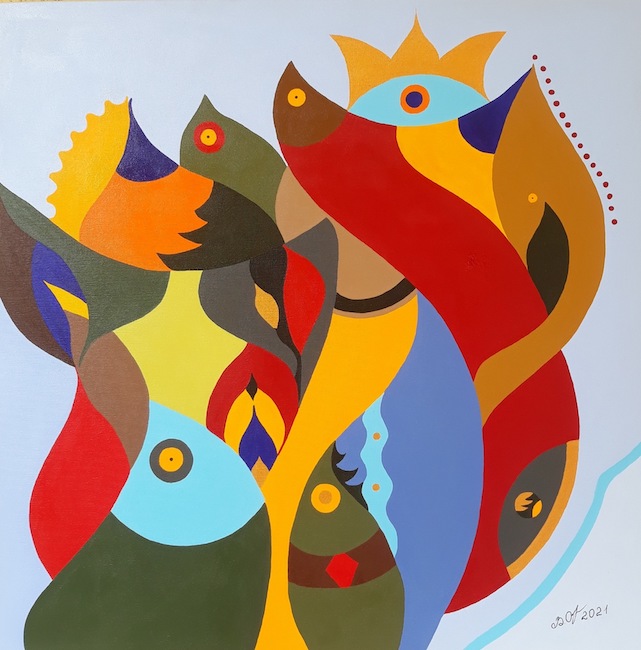
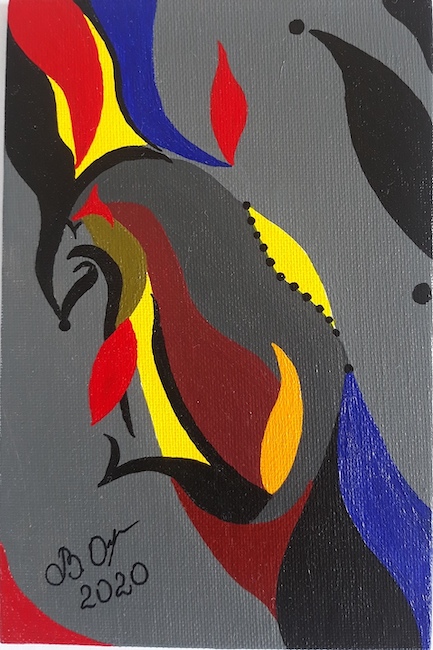
Di Malevich prende i colori primari, le basi bianche delle sue tele e i contrasti che contribuiscono a mettere in dialogo le figure protagoniste, dei Delauny prende la luminosità e l’ampliamento della gamma cromatica necessaria a dare voce più ampia ai personaggi e alle riflessioni dell’artista, e di Matisse mantiene lo sguardo ingenuo e fanciullesco che però non impedisce un approfondimento sulla realtà vissuta, sui risvolti dell’esistenza in cui l’uomo moderno si muove.
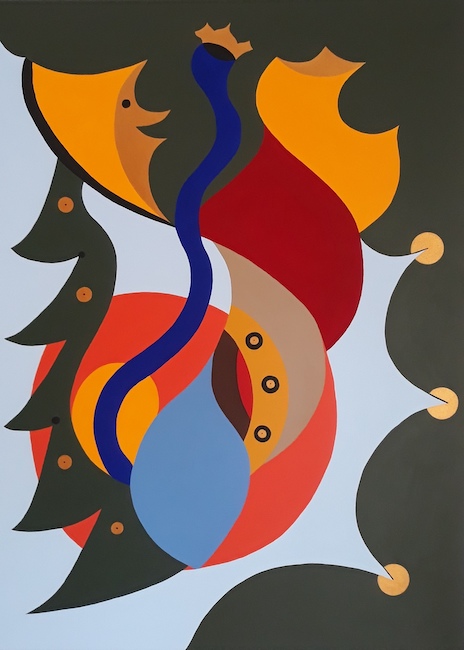
La semplicità espressiva, le immagini prive della terza dimensione e stilizzate quasi a far scomparire la figurazione per nasconderla in un’astrazione in cui resta comunque l’idea delle forme rappresentate e nelle quali lo sguardo cerca e coglie qualcosa di conosciuto, sono i tratti distintivi delle opere di Valentyna Ohurtsova che non perdono la luminosità di un approccio positivo, esplorativo e tendente all’evoluzione, tutte caratteristiche fondamentali per mantenere un equilibrio nella complessa vita moderna.
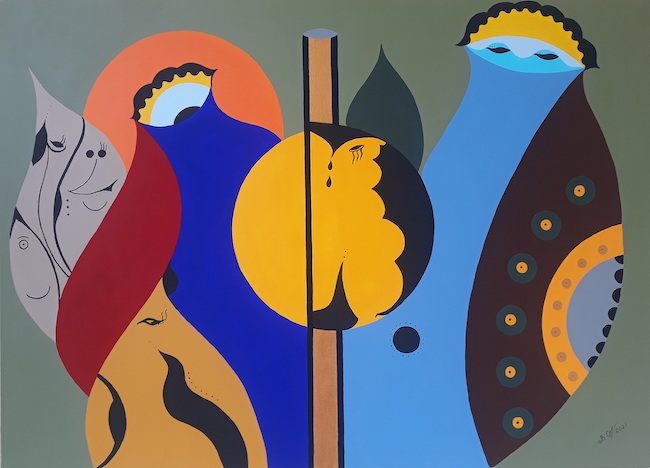
Nella tela Controllo della nostra esistenza la Ohurtzova evidenzia esattamente il concetto di bilanciamento, quel dover restare in piedi malgrado gli avvenimenti, quel non soccombere agli episodi più spiacevoli nella consapevolezza che poco dopo ne giungeranno altri più piacevoli a compensazione di ciò che sta finendo di accadere; la linea netta al centro dell’opera costituisce lo spartiacque, la demarcazione tra la fase positiva e quella più triste od ombrosa, tra un prima e un dopo che non fa altro che accrescere la conoscenza di sé e permettere all’individuo di evolvere divenendo più completo e consapevole della propria forza e della propria debolezza.
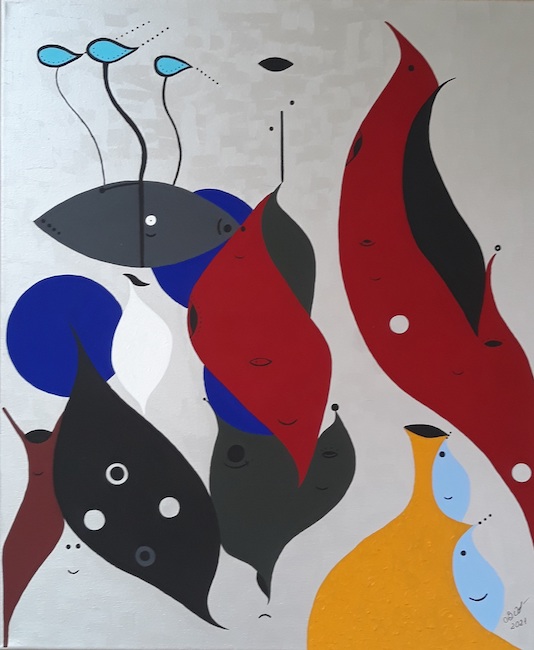
Lo stesso tema dell’autodeterminazione e della graduale acquisizione della sicurezza di sé è affrontato nell’opera Livello di coscienza, in cui l’artista mantiene la base dei colori primari cari a Malevich, pur ampliandoli leggermente con variazioni di grigio e di rosso più intenso; la fluttuazione delle figure geometriche oblunghe costituisce i diversi piani di esperienze in virtù delle quali il carattere si forma, le informazioni esterne vengono immagazzinate e il percorso di percezione consapevole di sé evolve e si solidifica attraverso la stratificazione di quelle esperienze e della reazione a esse.
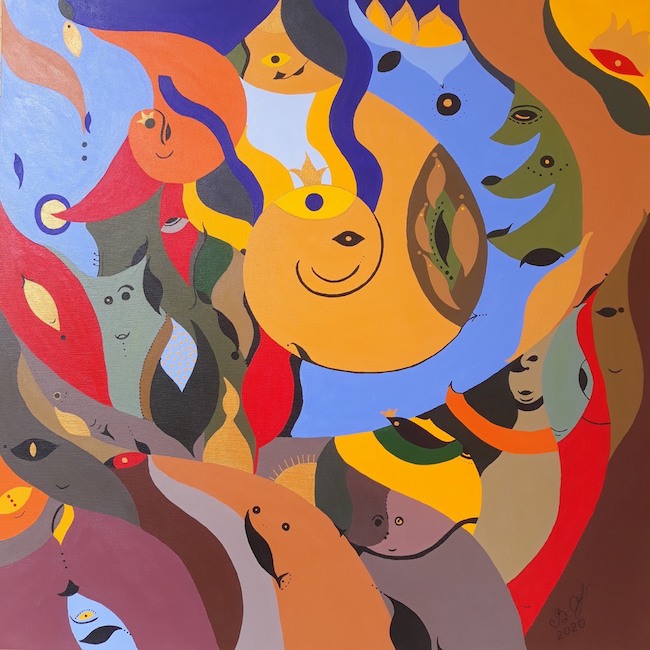
Nell’opera Un mondo tutto da scoprire la Ohurtsova mostra invece l’importanza dell’altro come coprotagonista della vita di ciascuno, perché malgrado la tendenza dell’uomo moderno all’isolamento e all’interagire attraverso la tecnologia è solo in virtù del contatto umano, dell’incontro e del confronto che è possibile osservare e scoprire i diversi modi di essere, di esprimersi, di manifestare le proprie emozioni; queste differenze sono linfa vitale per l’individuo poiché lo induce a comprendere la sua unicità, la sua singolarità che però non può e non dovrebbe mai essere vissuta come individualismo o contrapposizione all’altro, bensì come affermazione di un proprio modo di essere che ha bisogno di interrelazionarsi per continuare a mettersi in discussione e perciò progredire nel cammino di ricerca della propria vera essenza, che grazie al continuo scambio tende a modificarsi e a continuare a evolvere.
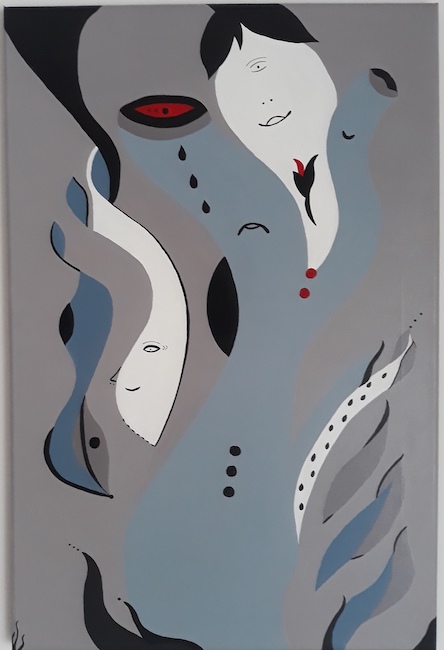
Nella tela Lo sguardo incantevole infine Valentyna Ohurtsova semplifica la gamma cromatica per mettere in evidenza il sentire, il percepire, le emozioni che appartengono al vivere di ciascuno, sia quando vengono negate o, per meglio dire, ignorate, sia quando vengono manifestate, a volte persino in modo esagerato per indurre gli altri a notarle; non importa, sembra dire l’artista, quale sia lo sguardo che ci viene rivolto, ciò che conta davvero è il modo in cui noi ci sentiamo, in cui consideriamo noi stessi sulla base di quanto sta accadendo, senza privarci della capacità di esprimere le sensazioni che da quel vissuto derivano. Il titolo richiama l’attenzione sull’incanto della vita, malgrado i suoi alti e bassi, malgrado i suoi sentieri tortuosi, perché tutto ciò che accade ha un suo senso che spesso viene compreso molto tempo dopo il momento in cui si sta verificando. Valentyna Ohurtsova ha all’attivo molte mostre collettive a Venezia, Roma, Milano, un’importante mostra personale a Venezia e una collettiva a Copenhagen e il suo percorso è in forte crescita.
VALENTYNA OHURTSOVA-CONTATTI
Email: valentynaarte@gmail.com
Facebook: https://www.facebook.com/valentina.ohurtzova.9
Instagram: https://www.instagram.com/artericamata/
Philosophical thoughts and observation of the human soul in the artworks of Valentyna Ohurtsova
Contemporary art often has the singular characteristic of presenting itself as a synthesis of different previous pictorial languages which, in the eras in which they developed, remained clearly detached and distant both in terms of their expressive rules and their creative intent; artists of the 21st century, on the contrary, tend to blur the boundaries and merge styles in order to give life to their own personal style of expression. The artist I am going to tell you about today belongs to that category of creatives who need to generate something new where there was none before.
The first decades of the twentieth century were a hothouse of innovations and upheavals in art as understood until the previous century, new thoughts that often tended to oppose each other, maintaining the firm principles and clear lines of demarcation that formalised their identity as theorised by their founders. And yet it was precisely the geniuses from which the major currents were born who gave a distinctive personal imprint to a way of doing and understanding painting that completely upset the academic and executive rules that had been adopted and considered the only ones possible until recently. In particular, there were a number of pictorial movements that wanted to distinguish themselves from the others that were more widespread and popular at the beginning of the 20th century, movements that appeared to be secondary or derivative of the others but that in reality, although more niche, had a relevance for further developments and contaminations of the art that followed at the beginning of the century. Kazimir Malevich was the founder of Suprematism, which also served as a theoretical basis for De Stijl, but he arrived at that abstraction through a path of simplification of the observed image, through an elimination of the third dimension and chiaroscuro of academic art, and a reduction of nuances in favour of full colour, almost with a graphic approach that slowly became more streamlined until it reached abstraction towards geometric forms and the exclusion of intermediate chromatic tones.
Cubism underwent a substantial change when Robert and Sonia Delauny brightened up its colours and at the same time moved towards a form of expression more oriented towards abstraction than figuration, while breaking down and fragmenting the lines, straight but mainly curved, which led them to hold on to the basic concept of the movement to which they adhered and which they modified into the one they founded called Orphism, or Orphic Cubism. And finally Henri Matisse, in his period of transition between the initial Fauve style followed by the Naïve phase first and then the Expressionist phase, and the period in which the foray into abstraction became more pressing, in turn simplified forms to the point of making them the supporting characters in a world in which the undulating shapes used to describe reality were more important than the main subject of the canvas, just as much as the flat, intense colours were used to narrate his world of eternal child. Valentyna Ohurtsova, an artist of Russian origin but resident in Venice for the last eighteen years, seems to present herself as a synthesis, or rather a conjunction of these three particular and unique styles that are necessary for her to observe and elaborate the reality around her, meditating on circumstances, events and everything that in some way envelops and involves the human soul and contemporary life.
From Malevich she takes the primary colours, the white bases of his canvases and the contrasts that contribute to the dialogue between the protagonist figures; from Delauny she takes the luminosity and the widening of the chromatic range necessary to give a wider voice to the characters and to the artist’s reflections, and from Matisse she keeps the naive and childish look that, however, does not prevent an in-depth examination of lived reality, of the aspects of existence in which modern man moves. The expressive simplicity, the images without the third dimension and stylised as if to make the figuration disappear and hide it in an abstraction in which the idea of the forms represented remains and in which the gaze seeks and grasps something known, are the distinctive features of Valentyna Ohurtsova’s artworks which do not lose the luminosity of a positive, exploratory approach tending towards evolution, all fundamental characteristics for maintaining a balance in complex modern life. In the canvas Control of our existence, Ohurtzova highlights exactly the concept of balance, that of having to remain upright despite events, that of not succumbing to the most unpleasant episodes in the knowledge that soon afterwards more pleasant ones will arrive to compensate for what is about to happen; the clear line at the centre of the work constitutes the watershed, the demarcation between the positive phase and the sadder or darker one, between a before and an after that only increases self-knowledge and allows the individual to evolve by becoming more complete and aware of his own strength and weakness. The same theme of self-determination and the gradual acquisition of self-confidence is addressed in the work Levels of Consciousness, in which the artist maintains the basis of the primary colours dear to Malevich, while slightly expanding them with variations of grey and deeper red; the fluctuation of the oblong geometric figures constitutes the different planes of experience by virtue of which character is formed, external information is stored and the path of self-aware perception evolves and solidifies through the stratification of those experiences and the reaction to them.
In her painting A World to Discover, Ohurtsova shows the importance of the other as a co-player in everyone’s life, because despite modern man’s tendency towards isolation and interaction through technology, it is only through human contact, encounter and confrontation that it is possible to observe and discover different ways of being, expressing oneself and manifesting one’s emotions; These differences are the lifeblood of the individual, as they lead him to understand his uniqueness, his singularity, which, however, cannot and should never be experienced as individualism or opposition to the other, but rather as the affirmation of his own way of being, which needs to interrelate in order to continue to be challenged and thus progress in the search for his true essence, which, thanks to continuous exchange, tends to change and continue to evolve. Finally, in the painting The Enchanting Gaze, Valentyna Ohurtsova simplifies the chromatic range to highlight the feeling, the perception, the emotions that belong to everyone’s life, both when they are denied or, better said, ignored, and when they are manifested, sometimes even in an exaggerated way to induce others to notice them; it does not matter, the artist seems to say, which gaze is directed at us, what really counts is the way we feel, the way we consider ourselves on the basis of what is happening, without depriving ourselves of the ability to express the feelings that derive from that experience. The title draws attention to the enchantment of life, despite its ups and downs, despite its winding paths, because everything that happens has its own meaning, which is often understood long after the moment it is happening. Valentyna Ohurtsova has to her credit many group exhibitions in Venice, Rome, Milan, a major solo show in Venice and a group show in Copenhagen, and her career is growing rapidly.
VALENTYNA OHURTSOVA-CONTACTS
Email: valentynaarte@gmail.com
Facebook: https://www.facebook.com/valentina.ohurtzova.9
Instagram: https://www.instagram.com/artericamata/


